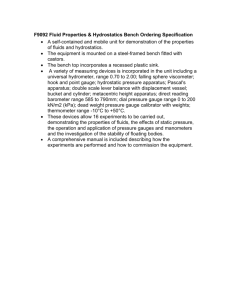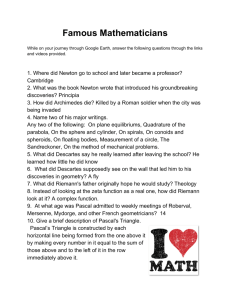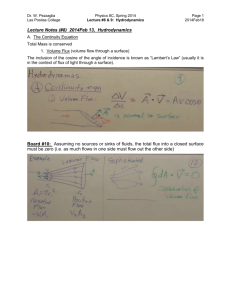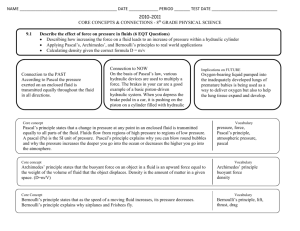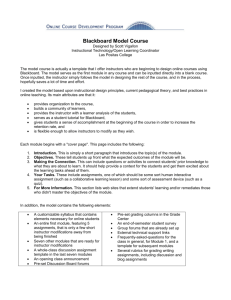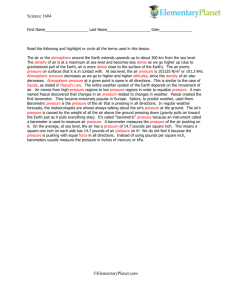boardnotes_hydrostatics
advertisement
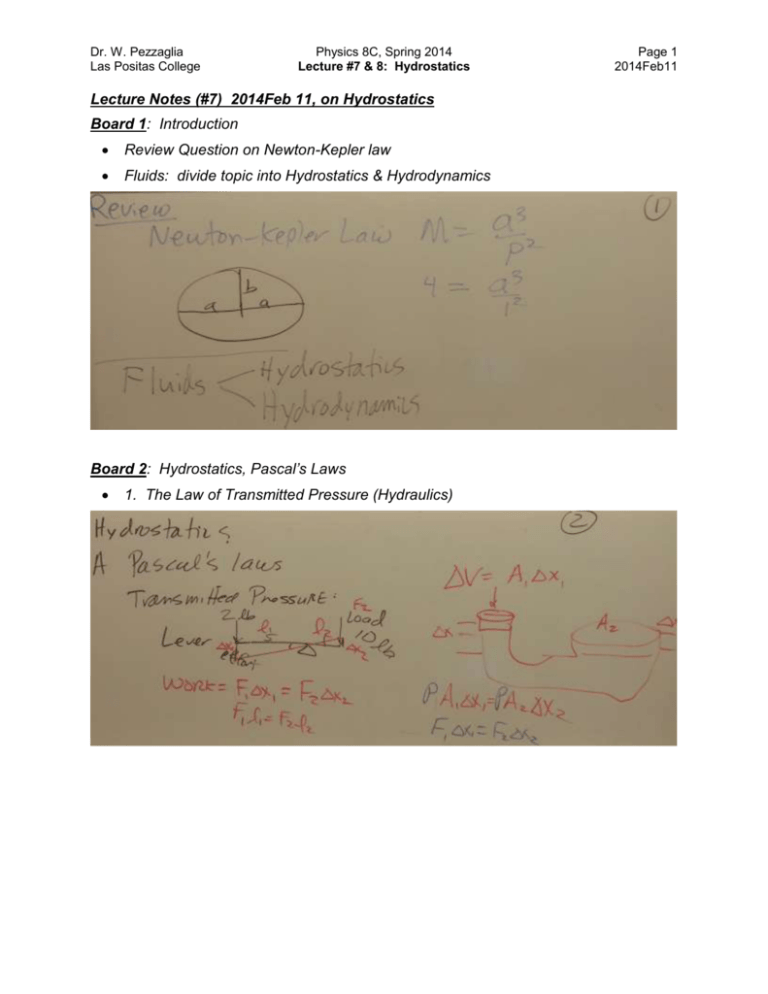
Dr. W. Pezzaglia Las Positas College Physics 8C, Spring 2014 Lecture #7 & 8: Hydrostatics Lecture Notes (#7) 2014Feb 11, on Hydrostatics Board 1: Introduction Review Question on Newton-Kepler law Fluids: divide topic into Hydrostatics & Hydrodynamics Board 2: Hydrostatics, Pascal’s Laws 1. The Law of Transmitted Pressure (Hydraulics) Page 1 2014Feb11 Dr. W. Pezzaglia Las Positas College Physics 8C, Spring 2014 Lecture #7 & 8: Hydrostatics Page 2 2014Feb11 Board 3: Hydrostatics, Pascal’s Laws 2. Pascal’s Law of Depth Note for liquids, the density usually is constant (incompressible). For gasses however, density will change with height so you must do the integral. Board 4: Law of Depth Continued The pressure at A, B, C, D will all be the same. Note the pressure at “Q” will be LESS than atmospheric pressure P 0 ! So, if “Q” was even higher, the pressure would be lower. At some maximum height the pressure would be zero, and this is as high as you could make a “siphon”. Any higher, you would get “vacuum” in the tube. Dr. W. Pezzaglia Las Positas College Physics 8C, Spring 2014 Lecture #7 & 8: Hydrostatics Page 3 2014Feb11 Board 5: Barometers, Maximum height of a column Inverting a sealed tube of water into an open dish, the pressure in the tube will decrease as you move up the tube. At the maximum height, the pressure will be zero. Above that height, it will be an empty vacuum. By Pascal’s law of depth, you can calculate the height of the water column. It would approximately be 10 meters. This is the maximum height that you could suck water up a straw with a vacuum pump. If instead you use Mercury, the height would be 760 mm (around 30 inches). Board 6: Differential Form of Pascal’s law depth Instead of the integral equation, we can express the general Pascal’s law as a differential equation. The gradient of the pressure is equal to the body force density on the fluid (i.e. force per unit volume equals density time gravity field). Ignoring centrifugal forces, the only body force we probably have is gravity. Dr. W. Pezzaglia Las Positas College Physics 8C, Spring 2014 Lecture #7 & 8: Hydrostatics Page 4 2014Feb11 Board 7: Example Calculation: Pressure at center of earth Previously we have shown that the gravitational field increases linearly from the center of earth (where its zero) to the surface (where its g=9.8 m/s 2). By integration we find the pressure at the center of the earth. Note, recalling the acceleration of gravity is given by: g GM , and density is R M 3GM 2 , we get . P 4 R 3 8R 3 3 Putting in numbers (R=6371 km, M=5.971024 kg, =5500 kg/m3), gives us 171109 Pascals. The true value is nearly twice as much. The reason is the density at the center (iron) is much greater than in the mantel (silicon). Board 8: Comment on Fundamental Theorem of Calculus The path integral of a gradient of a function only depends upon the values of the function at the endpoints. Its path independent. This is essentially why Pascal’s law only depends upon the depth; it doesn’t care if you go sideways in the fluid. Dr. W. Pezzaglia Las Positas College Physics 8C, Spring 2014 Lecture #7 & 8: Hydrostatics Page 5 2014Feb11 Lecture Notes (#8) 2014Feb 13, Hydrostatics continued Board 1: Conundrum Problem on Pascal’s Law One finds that the (downward) pressure at “B” inside the fluid calculated by Pascal’s law of depth (a) is greater than pressure upward on the container by the normal force of the table (b). Why? Isn’t this a contradiction? Violation of Newton’s 2nd and 3rd laws? Board 2: Solution comments (sorry, its fuzzy) Solution: One must consider the forces on the container. Indeed the downward force due to fluid (pressure at “B” times area of base) is greater than the upward normal force from the table. The discrepancy is that the fluid exerts an upward force on the annulus due to pressure at “A”. Dr. W. Pezzaglia Las Positas College Physics 8C, Spring 2014 Lecture #7 & 8: Hydrostatics Page 6 2014Feb11 Board 3: Solution comments continued Here I show the sum of the forces on the container. You can show by substitution that it all works out. Board 4: The Atmospheric Problem While liquids are incompressible (density does not change very much with pressure), that is not true for gasses. Using the ideal gas law, we can show that the (mass) density is proportional to the pressure. Dr. W. Pezzaglia Las Positas College Physics 8C, Spring 2014 Lecture #7 & 8: Hydrostatics Page 7 2014Feb11 Board 5: Atmospheric Problem We simplify our problem by assuming that the temperature of the atmosphere is constant. [This is really not true at all. In the Troposphere the temperature decreases with altitude, but in the Stratosphere it increases until you hit the ozone layer where uv light is absorbed and hence dumps in heat, then above that in the mesosphere it gets colder, but heats up again in the ionosphere due to absorption of x-rays and such.] From differential form of Pascal’s law, we know the pressure gradient equals the action of gravity on the gas. Substituting for the density (from the gas law) we get an differential equation that can be integrated. Board 6: Atmospheric Problem, Solution The solution is that the pressure exponentially decays with altitude. The “scale height” for the earth’s atmosphere is approximately 8 km, but this varies with temperature (increases to 8.5 km for 17C increase in temperature). For planet Saturn its about 60 km. Dr. W. Pezzaglia Las Positas College Physics 8C, Spring 2014 Lecture #7 & 8: Hydrostatics Page 8 2014Feb11 Board 7: B. Archimedes Principle The powerpoint slides do a fairly good job at this topic, so I won’t add too many extra notes here. Buoyancy force is equal to the weight of water displaced. Board 8: How to measure density of a block of substance that is heavier than water Part C: SURFACE TENSION: There was a very short lecture on surface tension and capillary action. These topics are “skipped” in your textbook, and for brevity we will not cover them (although you will use capillary action in lab to measure the diameter of our thin pipes). -end of hydrostatics-
